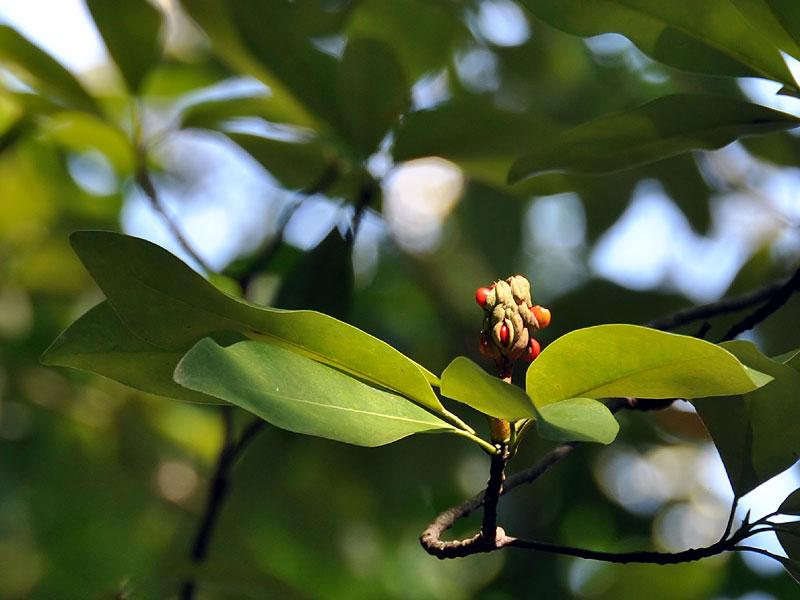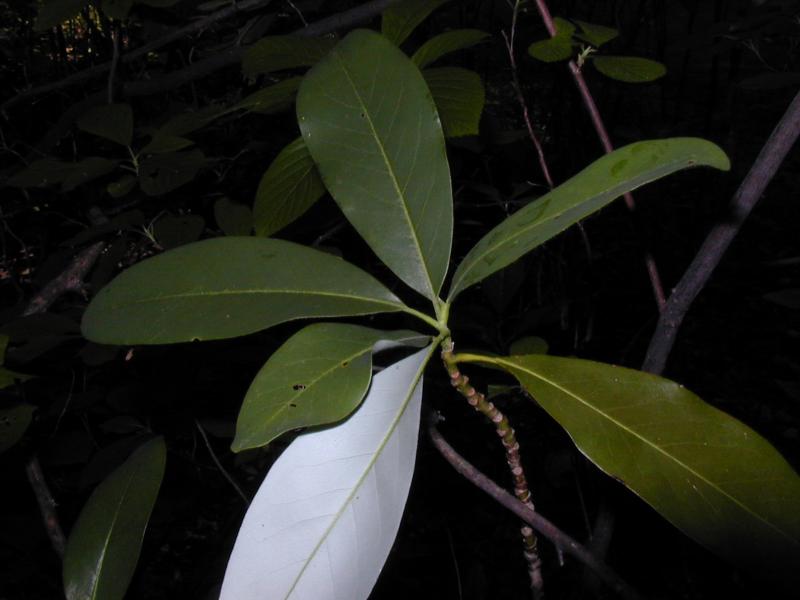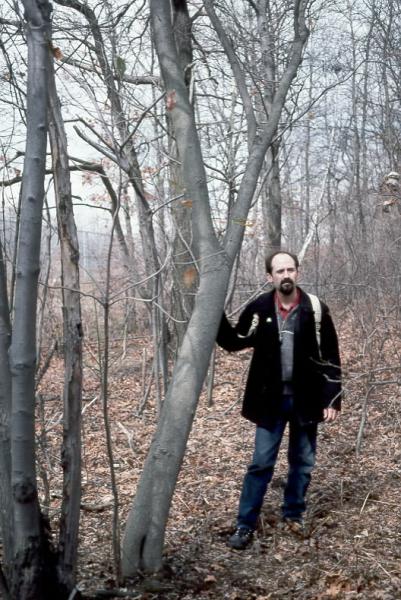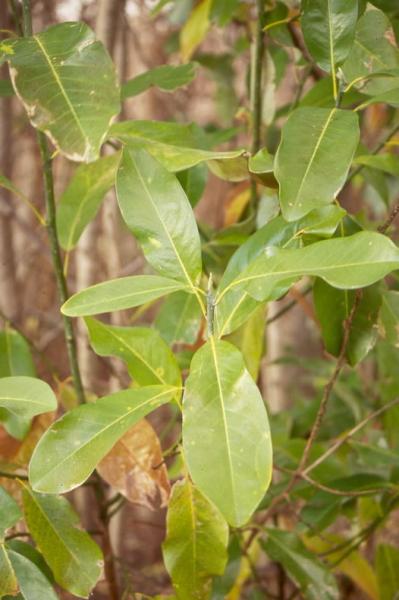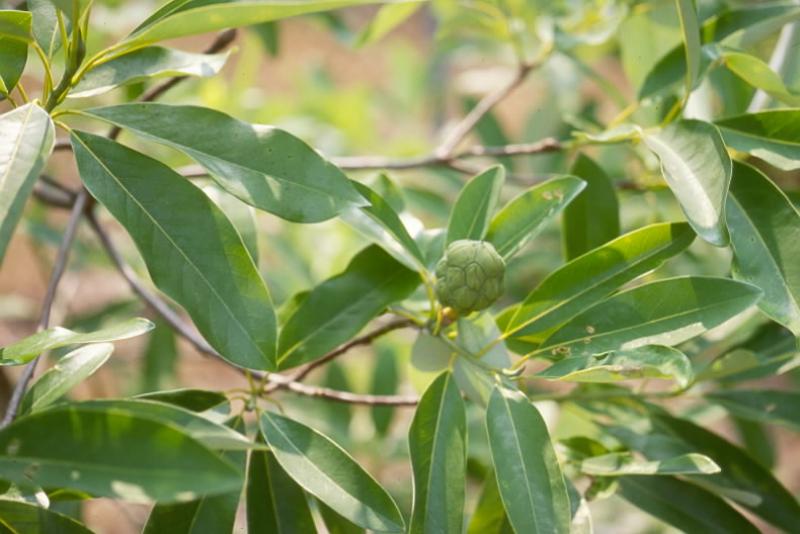Sweetbay Magnolia
Magnolia virginiana L.
- Class
- Dicotyledoneae (Dicots)
- Family
- Magnoliaceae
- State Protection
- Endangered
Listed as Endangered by New York State: in imminent danger of extirpation in New York. For animals, taking, importation, transportation, or possession is prohibited, except under license or permit. For plants, removal or damage without the consent of the landowner is prohibited.
- Federal Protection
- Not Listed
- State Conservation Status Rank
- S1
Critically Imperiled in New York - Especially vulnerable to disappearing from New York due to extreme rarity or other factors; typically 5 or fewer populations or locations in New York, very few individuals, very restricted range, very few remaining acres (or miles of stream), and/or very steep declines.
- Global Conservation Status Rank
- G5
Secure globally - Common in the world; widespread and abundant (but may be rare in some parts of its range).
Summary
Did you know?
This tree has been in the horticultural trade since 1688 (Dirr 1975) making it hard at times to distinguish between natural populations and trees that have escaped from ornamental plantings.
State Ranking Justification
There are eight existing populations but none with more than 50 trees. Four of the populations may have been planted, But is difficult to tell without more study. There are two historical populations from 1884 and 1916 respectively, but they no longer exist.
Short-term Trends
The short-term trend of most populations appears stable although some trees were were lost when one location was bulldozed during building construction.
Long-term Trends
The long-term trend appears stable. This tree has always been rare in New York with only a few populations and they will continue to remain at low levels for the foreseeable future.
Conservation and Management
Threats
Populations are in small natural areas and not protected from future development or secondary effects from nearby houses and roads.
Conservation Strategies and Management Practices
A natural buffer should be established around the populations to prevent direct disturbance or changes in hydrology.
Research Needs
Studies should be done to see if populations can be augmented.
Habitat
Habitat
In New York this tree grows in red maple hardwood swamps and red maple sweetgum swamps. Sometimes they are isolated within the swamp or quite close to development. The soils can be wet, saturated, or somewhat drier near development (New York Natural Heritage Program 2012). Wet woods and margins of swamps (Gleason and Cronquist 1991). Swamps and low woods (Fernald 1950).
Associated Ecological Communities
- Red maple-blackgum swamp
(guide)
A maritime, coastal, or inland hardwood swamp that occurs in poorly drained depressions, sometimes in a narrow band between a stream and upland. Red maple and blackgum are often codominant or blackgum may be the dominant tree. Pitch pine may occur on drier hummock islands in pine barrens settings.
- Red maple-hardwood swamp
(guide)
A hardwood swamp that occurs in poorly drained depressions, usually on inorganic soils. Red maple is usually the most abundant canopy tree, but it can also be codominant with white, green, or black ash; white or slippery elm; yellow birch; and swamp white oak.
- Red maple-sweetgum swamp
(guide)
A hardwood swamp that occurs on somewhat poorly drained seasonally wet flats, usually on somewhat acidic soils. Red maple-sweetgum swamps often occur as a mosaic with upland forest communities. Sweetgum is often the dominant tree or may be codominant with red maple. Other codominant trees include pin oak and blackgum.
Associated Species
- Acer rubrum
- Acer saccharinum (silver maple)
- Clethra alnifolia (coastal sweet-pepperbush)
- Erythronium americanum
- Ilex glabra (inkberry)
- Liquidambar styraciflua (sweet-gum)
- Lysimachia terrestris (swamp-candles)
- Maianthemum canadense (Canada mayflower)
- Nyssa silvatica
- Onoclea sensibilis (sensitive fern)
- Osmunda cinnamomea
- Osmunda regalis
- Phragmites australis (old world reed grass, old world phragmites)
- Quercus bicolor (swamp white oak)
- Quercus phellos (willow oak)
- Quercus rubra (northern red oak)
- Rhododendron viscosum (swamp azalea)
- Rubus
- Smilax glauca (white-leaved greenbrier)
- Smilax rotundifolia (common greenbrier)
- Sphagnum
- Symplocarpus foetidus (skunk-cabbage)
- Toxicodendron vernix (poison-sumac)
- Vaccinium corymbosum (highbush blueberry)
- Verbena hastata (blue vervain)
- Vitis riparia (river grape, frost grape)
Range
New York State Distribution
It was once known from Westchester County southeast to Suffolk County on Long Island. It is currently known from Staten Island and Long Island south of the moraine.
Global Distribution
This tree is most common in the southeastern US from Texas north to New Jersey. It becomes rare to the north from Pennsylvania to Long Island and eastern Massachusetts.
Identification Comments
General Description
Sweetbay Magnolia is a tall shrub or slender tree that grows up to 20 meters tall but is usually shorter at its northern range limit. The gray to grayish brown, smooth, thin bark is irregularly furrowed and composed of small plates. It is often mottled and is aromatic when crushed. The winter bud is up to 2.5 cm long and finely silky. The leathery leaves are deciduous this far north. They are oblong, elliptic or even oblanceolate and 8-15 cm long and about a third to half as wide. The margins have no teeth and the undersides are whitish and finally hairy which contrasts to the deep green hairless upper side. The large, fragrant, flowers have leathery, concave, white petals, about 9-12 cm long. The fruit is a small cone-like structure that releases bright red seeds that are suspended on a hair-like strand (funiculus) (Gleason and Cronquist 1991, Elias 1980).
Identifying Characteristics
Distinguishing characteristics: leaf bud silky; leaves 0.8-1.5 dm long, obtuse, subcoriaceous, evergreen to deciduous (mostly deciduous northward), glaucous and glabrous beneath; flower subglobose; petals roundish-obovate; fruiting cone ellipsoid, 3-5 cm long. Best life stage for ID: in leaf. Characteristics needed to ID: leaves.
Best Life Stage for Proper Identification
This tree can be identified in the winter by its bark and buds but is best identified in the summer by its leaves and/or flowers.
Similar Species
In New York there are no other shrubs or trees that look similar to this species.
Best Time to See
This species flowers in June and fruits persist to early November. It can be identified vegetatively at any time of year.
- Vegetative
- Flowering
- Fruiting
The time of year you would expect to find Sweetbay Magnolia vegetative, flowering, and fruiting in New York.
Sweetbay Magnolia Images
Taxonomy
Sweetbay Magnolia
Magnolia virginiana L.
- Kingdom Plantae
- Phylum Anthophyta
- Class Dicotyledoneae
(Dicots)
- Order Magnoliales
- Family Magnoliaceae
- Order Magnoliales
- Class Dicotyledoneae
(Dicots)
- Phylum Anthophyta
Additional Common Names
- Magnolia-bay
- Swamp-bay
- Sweet-bay
Additional Resources
Best Identification Reference
Flora of North America Editorial Committee. 1997. Flora of North America, North of Mexico. Volume 3. Magnoliophyta: Magnoliidae and Hamamelidae.
Other References
Crow, Garrett E. and C. Barre Hellquist. 2000. Aquatic and Wetland Plants of Northeastern North America: A revised and enlarged edition of Norman C. Fassett's a Manual of Aquatic Plants. Volume One: Pteridophytes, Gymnosperms, and Angiosperms: Dicotyledons. The University of Wisconsin Press. Madison, Wisconsin. 536 Pages.
Dirr, M.A. 1990. Manual of Woody Landscape Plants. Stipes Publishing Company, Champaign, Illinois. 1007 pp.
Fernald, M.L. 1950. Gray's manual of botany. 8th edition. D. Van Nostrand, New York. 1632 pp.
Gleason, Henry A. and A. Cronquist. 1991. Manual of Vascular Plants of Northeastern United States and Adjacent Canada. The New York Botanical Garden, Bronx, New York. 910 pp.
Holmgren, Noel. 1998. The Illustrated Companion to Gleason and Cronquist's Manual. Illustrations of the Vascular Plants of Northeastern United States and Adjacent Canada. The New York Botanical Garden, Bronx, New York.
House, Homer D. 1924. Annotated list of the ferns and flowering plants of New York State. New York State Museum Bulletin 254:1-758.
Little, E.L., Jr. 1979. Checklist of United States trees (native and naturalized). Agriculture Handbook No. 541. U.S. Forest Service, Washington, D.C. 375 pp.
Mitchell, Richard S. and Ernest O. Beal. 1979. Magnoliaceae to Ceratophyllaceae of New York State. New York State Museum Bulletin 435, 62 pp.
New York Natural Heritage Program. 2010. Biotics database. New York Natural Heritage Program. New York State Department of Environmental Conservation. Albany, NY.
New York Natural Heritage Program. 2024. New York Natural Heritage Program Databases. Albany, NY.
Rhoads, Ann F. and Timothy A. Block. 2005. Trees of Pennsylvania. A Complete Reference Guide. University of Pennsylvania Press, Philadelphia, PA.
Weldy, T. and D. Werier. 2010. New York flora atlas. [S.M. Landry, K.N. Campbell, and L.D. Mabe (original application development), Florida Center for Community Design and Research http://www.fccdr.usf.edu/. University of South Florida http://www.usf.edu/]. New York Flora Association http://newyork.plantatlas.usf.edu/, Albany, New York
Links
About This Guide
This guide was authored by: Stephen M. Young
Information for this guide was last updated on: September 20, 2012
Please cite this page as:
New York Natural Heritage Program. 2024.
Online Conservation Guide for
Magnolia virginiana.
Available from: https://guides.nynhp.org/sweetbay-magnolia/.
Accessed July 27, 2024.
